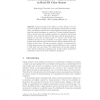Free Online Productivity Tools
i2Speak
i2Symbol
i2OCR
iTex2Img
iWeb2Print
iWeb2Shot
i2Type
iPdf2Split
iPdf2Merge
i2Bopomofo
i2Arabic
i2Style
i2Image
i2PDF
iLatex2Rtf
Sci2ools
107
Voted
IWINAC
2005
Springer
2005
Springer
Model Performance for Visual Attention in Real 3D Color Scenes
Abstract. Visual attention is the ability of a vision system, be it biological or artificial, to rapidly detect potentially relevant parts of a visual scene. The saliency-based model of visual attention is widely used to simulate this visual mechanism on computers. Though biologically inspired, this model has been only partially assessed in comparison with human behavior. The research described in this paper aims at assessing its performance in the case of natural scenes, i.e. real 3D color scenes. The evaluation is based on the comparison of computer saliency maps with human visual attention derived from fixation patterns while subjects are looking at the scenes. The paper presents a number of experiments involving natural scenes and computer models differing by their capacity to deal with color and depth. The results point on the large range of scene specific performance variations and provide typical quantitative performance values for models of different complexity.
Related Content
| Added | 28 Jun 2010 |
| Updated | 28 Jun 2010 |
| Type | Conference |
| Year | 2005 |
| Where | IWINAC |
| Authors | Heinz Hügli, Timothée Jost, Nabil Ouerhani |
Comments (0)

